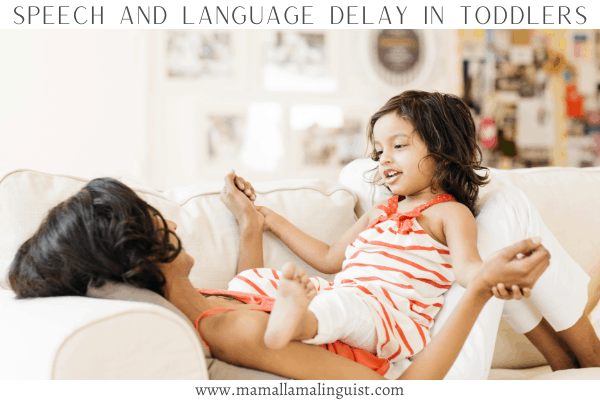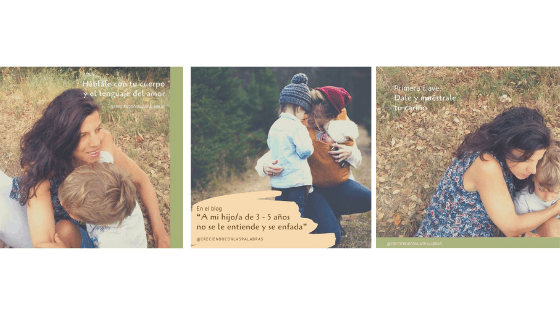In this post: How to recognize if your bilingual toddler has a speech delay and six steps you can take to support your child’s language development at home.
Are you raising a bilingual child and worried that they may have a speech delay?
Do you need expert advice on how to actually diagnose whether your child has a language delay or not?
There are many misconceptions and common myths about raising bilinguals and the correlation to speech delays. Firstly, let’s just clarify that bilingualism does NOT cause language delays.
This post explains how to recognize a speech delay and six important steps for how to help the child.

This guest post has been translated into English by Corrie Wiik. To read the original in Spanish please visit Estela’s website here.
How do I know if my child has a language delay?
Are you asking yourself this question, mama? Or have you made any of these comments lately:
“My child isn’t developing at the same speed as other children”
“I find it difficult to not compare my child to other children”
“My son doesn’t speak very well and I don’t know if I should be worried”
“My daughter doesn’t pronounce things properly”
The issue is you don’t know whether to be concerned, consult a specialist, or if there is something you can do to help them. It’s not the same if we’re talking about a child at the beginning stages of speech development as a child who already has a decent amount of vocabulary but is hard to comprehend.
In general, in order to know if your child has a language delay, you need to understand a few things.
Normal Language Development
First, you need to know what the characteristics are of children’s language. The charts for normal language development tell us what the children have to learn, what they should know how to do, and say at each level/age. However, these charts have their limitations.
Firstly, they don’t take into account the uniqueness of bilingual children. Secondly, they should also be taken only as guidelines, and not literally.
In my professional experience, the differences in language acquisition and language development between children are huge. There are children between the ages of two and three who barely speak at all, but after a few years catch up to the level of their peers. However, in a therapy clinic they would diagnose them as children with a language delay.
Language Delay: A Definition
Language delay is defined as a delay in the production or development of language, above all in the spoken form. Language production is more delayed and develops slowly. The child is put in the “correct” level when they reach five or six years of age, even with no type of intervention.
What I question is: Why label them with a “language delay” if they will undoubtedly catch up eventually? These words only add more worry to moms and this could be avoided.
I always speak about the different styles and rhythms of learning. In order to provide the appropriate help we don’t need to have a label, but rather, we need to be able to understand how communication functions. This includes knowing that in almost all cases of a diagnosis, the advice given is overall the same: provide an environment that is rich in communication and make certain adjustments.
In any case, I understand the WHY for classifications. They provide a guide or a reference to see if development is indeed taking place, even if it’s later. In addition, language delay is not the same as language disorder which can affect comprehension and various aspects of communication.
Related Post: 5 Benefits of Bilingualism
Early Language Evaluation
An early evaluation is very important because it allows us to know if progression is happening and, above all, that no signs are showing that anything more important is coming into play (like a language disorder or other developmental disorders).
Equally, there are characteristics for each language development stage that ought to be taken as guides. There are also “warning signs” that ought to be taken into account, too.
When I do a language evaluation, I focus on their language. But not only on the language that you “hear”, like their sounds, vocalizations or words, but also in the language that you “see”.
Reassuring Behaviors:
The language that you see is global communication:
- Their intention and desire to communicate
- The way they look at their mom and towards objects
- Their smiles, gestures, and finger that signals
- What they understand when their mom tells them or asks them something
- Their ability to show things, to enjoy the relationship, to be interested in their environment
- To accept or reject, to greet and say goodbye
- To play in a certain way
- To imitate the actions and sounds of their mom
All these characteristics are a good sign that the language is developing, even though there may not be words yet.

Concerning Behaviors
In other words, we ought to worry only when the child does not show these behaviors. If the child:
- Doesn’t imitate
- Doesn’t look in your eyes
- Seems not to understand what you tell them, or doesn’t follow simple directions
- Doesn’t communicate with gestures, nor with their face
- Doesn’t make vocalizations, nor sounds
- Seems incapable of asking for things properly
- or playing in an imaginary way
In such cases, yes it is, without a doubt, the right moment to consult a specialist.
Related Post: How to Raise a Bilingual Child
In the majority of cases where there is little verbal language (language that you hear), they do indeed show all the characteristics of normal communication (the language that you see). In this case, early intervention is also important in order to give the appropriate help in driving forward language use. But the word ‘appropriate’ is very important. I’m not talking about intervening for the sake of intervening, nor doing direct or educational activities, nor advancing the normal processes of acquisition.
I’m talking about knowing the effective communication tools that maximize and make the most of all the bonding moments and communication at home, in order to supply a rich language environment. Not doing special activities, but rather using the normal daily routines (meal times, bath times, getting dressed, walks, shopping…) and play and story time.
These moments have a structure and very defined characteristics in which language can repeat itself. This favors language acquisition and your child can start to use these words.
Six Ways to Help a Child with a Speech Delay
Therefore, you need to make certain adjustments in these interactions and in your communication so that you can become their language stimulator. It’s important that:
- Spend a chunk of quality time with your child every day, being present and observing and listening attentively to them, to make you an expert in their communication.
- Enjoy these moments and your relationship with them, and the wonder that it is to see them grow.
- Follow their initiative and adapt to them, letting them show you what interests them, what they wish to play and who they want to read about in a story.
- Don’t ask too many questions and be sure to give them the necessary time to express themselves, perhaps even just with a gesture, a facial expression, a sound, a vocalization or a word.
- Provide them with a correct language model, with clear pronunciation, an unhurried and deliberate rhythm, and an agreeable tone of voice with gestures.
- Correct their words and pronunciation in an implicit way, without them realizing, so making sure to never make them repeat you.


